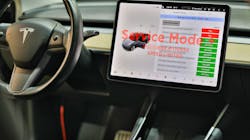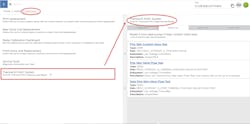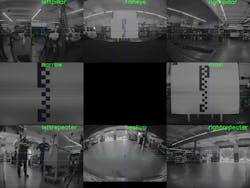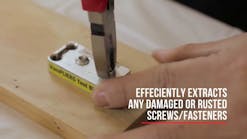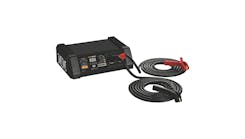Recently, Tesla made its diagnostic software available to the public, with Tesla Toolbox 3 now available across North America. Toolbox 3 is a web application that runs on the Chrome browser and requires a special cable to connect.
Toolbox 3 will connect to Atom-based systems which means that 2018 and later Model's S, 3, X, & Y can be accessed in the aftermarket. For earlier vehicles (Tegra-based), the Toolbox 2 application is required which isn't available to the aftermarket. Telsa has indicated that they will be trying to support those vehicles under Toolbox 3 in the future.
Now available on the Tesla’s automaker page on the NASTF website, technicians can find instructions for setting up the Tesla diagnostic tool, service information requests, PSA videos that explain how the systems works, and service subscription pages.
Since more Teslas might soon be showing up in your independent repair shops, there are some important elements to keep in mind when servicing these vehicles:
1. Understand the car is actually the scan tool
This is very different for many technicians and shop owners who are likely not used to doing things directly to the vehicle over the cloud.
You still have to access the car with the connector but what you're doing is you're sending a token, as they call it, to unlock the cluster and unlock the gateway and the gateway is actually the MCU. The cluster has the token in the early cars, the later cards it's on the MCU. Once you unlock the MCU with the token, then you're able to perform all the data requisitions, all the programming requests, firmware updates, and all of those functions but that all takes the Toolbox to unlock it because that's the secure data,” said Seth Thorson, president of Eurotech Automotive, in a recent LinkedIn Live event hosted by Motor Age.
2. Make sure you’re in service mode
Before doing any work on a Tesla, you will want to make sure the vehicle is in Service Mode+, so that the center stack becomes a diagnostic interface that the technician can use to perform certain vehicle operations without having the laptop connected to the vehicle. The Tesla will stay in service mode until the tech exits that mode.
This mode also disconnects the customer from their mobile app that operates their car. You don’t want to be in sentry mode which is like a theft recording capability that can record out of certain cameras in the vehicle.
“In live sentry [mode] you can turn the cameras on on your car and see what's going on and talk to somebody on the outside of your car at any given time so those would be the things that you might not want inside your shop,” Thorson said. “Live cameras that the customer can capture and record and do anything they want with wherever they're at so those are the things that you want to be wary of.”
3. Know the secret code
Technicians are no strangers to going through a series of weird actions to have a vehicle complete a specific command. For Tesla, to unlock most of functions in the car, you have to hold the brake and hold the turn signal up at the same time.
“It's not very intuitive but then that unlocks the service menu then you can do your cooling system bleed and all these things,” Thorson explained.
4. Be prepared for a learning curve
There are many things to learn before conducting a repair on a Tesla and it will take some time to be Tesla proficient. For example, the data lines that show up are not like what you would normally see as a data PID list on a Snap-on or Autel scan tool; they’re more like a line of code, said Pete Meier, director of training at Motor Age who moderated the event.
“They tell you what they are, and you can decipher them if you have some understanding, but i just want to caution that for the shop owners and techs that are looking at this, it's going to take some training,” Meier said. “If you have some Tesla customers, you want to be cautious about diving into this."
5. Embrace a new line of business
Having access to Toolbox 3 enables independent repair shops to extend Tesla service to their customers and bring in some new revenue.
“This software, at least on these models, is going to give me the ability to add additional service opportunities in terms of doing those routine services that we're kind of used to right whether it comes to the brakes or the cooling system or wheel alignment or tires by putting [the vehicle] in the service mode and then accessing those different functions, similar to what we're used to,” Meier said.
Having this software allows techs to do the work properly, such as being able to reset the steering angle sensor after a wheel alignment, added Scott Brown, President of Diag.net and contributing editor for PTEN, who was also on the LinkedIn Live event panel.
A long time coming
NASTF has been trying to work with Tesla since 2017. At their first meeting, Tesla was just trying to get help with getting around the Right to Repair, said Donny Seyfer, executive director for NASTF, who also spoke on the panel.
“Of course that didn't really bear any fruit for them,” he said. “[Then later on] we had a conversation with them and we thought that was another dead end, and then lo and behold a few weeks later I get a call from one of them saying, ‘Hey we would like to use SDRM.’ And I said, ‘Well, that's great but how are people going to actually use SDRM if they don't have access to your scan tools or your service information?’”
In the initial launch of Tesla Toolbox for the aftermarket, there was not access to the older cars — kind of important for the repair community. Now, 2018 and later is available with Tesla promising they are working on adding earlier vehicles too.
“They haven't been experienced like other automakers are and kind of how all of this stuff works. They've got very sharp people, no doubt about that, but some of this stuff is just completely new to them, so some of the meetings we have with them are like meetings NASTF was having 20 years ago with other automakers,” said Seyfer. “So, it's moving along.”
Photos provided by Scott Brown
Related content:
Tesla's Model Y uses die-cast aluminum 'mega castings'
Tesla accounts for more than 80 percent of electric vehicles sold in the US
